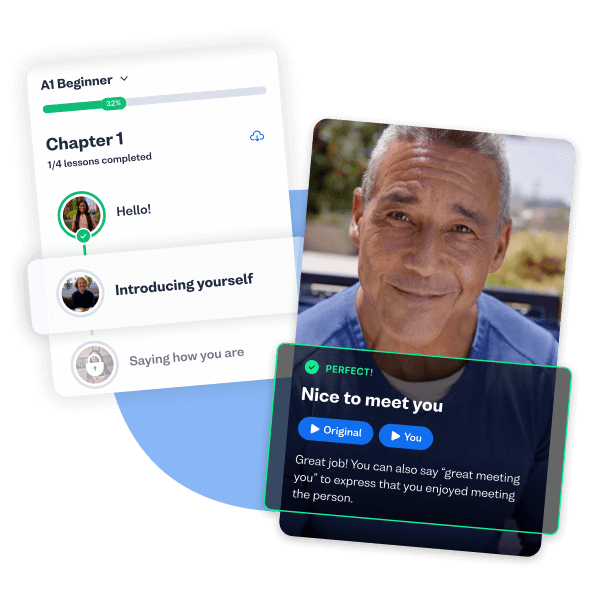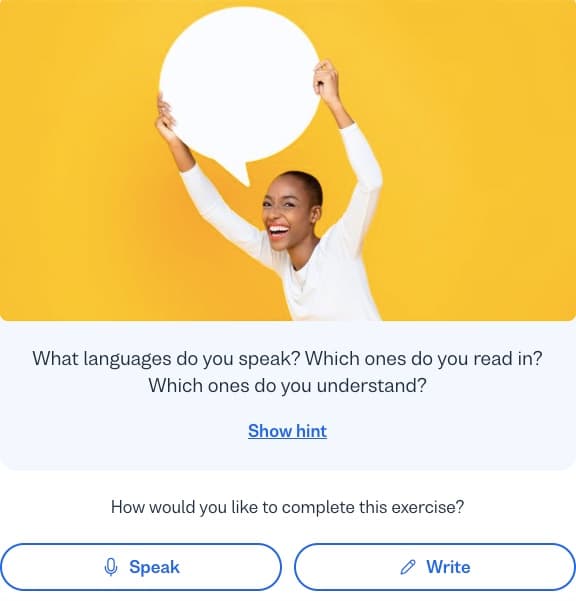I want to learn...
Becoming a polyglot as an adult is tough, but not impossible. Billions of people around the world have mastered second and third languages. Millions have even become fluent in a fourth language.
But you can bet most of them (unless they grew up in a multilingual environment) did it sequentially. They mastered one language, then moved on to the next. Some people, however, study two new languages simultaneously.
That might sound crazy to most people. But research shows that simultaneous learning doesn’t get in the way of language acquisition and can even be a motivator. That doesn’t mean it’s easy. Doing it simultaneously has unique challenges that you need to overcome.
In this article, you’ll learn about 10 tips to help you learn two languages at the same time.
1. Be kind to yourself
Learning a new language includes taking risks. You challenge yourself. You put yourself out there. And because of the complex processes involved, you challenge your self-concept. This causes language anxiety which (no surprises here) negatively correlates with learning achievement.
This research only looks at people learning one new language. When you learn two at the same time, language anxiety might be even worse. You’re giving yourself twice the work to do. So it makes sense that pressure and stress also increases.
It’s important to be kind to yourself. Learning two new languages is unlikely to be a smooth process. So if things don’t go well, don’t be hard on yourself. Pat yourself on the back for taking on such a hard task in the first place. And remember that a ton of learning happens when things don’t go well.
2. Do it for the right reasons
Quality of motivation matters. Some external motivators—but, importantly, not all— lead to low-quality motivation and harm achievement. Things like peer pressure, academic tests, and monetary payments might lead to low-quality motivation.
So when you decide to take on a mammoth task like learning two languages at once, do it for the right reasons. This way you’re more likely to stick with it until the end. And you guarantee better learning outcomes.
3. Make it fun
When something is fun, it’s easier to build—and stick with—habits. Consistency is key when learning a new language. This is even more true when taking on two languages at once. Try and inject some fun into your learning. Here are some ways to do that:
Play word games
Join group lessons
Find a language exchange buddy
Do your hobby in your new languages
Travel and practice speaking with the locals
Consume your favorite content in your new languages
Practice with native speakers in the Busuu app
4. Keep your expectations in check
Tackling two new languages at once isn’t the quickest way to become fluent. You need to understand it might take a while to see results. So make sure you set realistic goals. For example, tests are a common goal for language learners. But tests are a big cause of foreign language anxiety. If you plan to take tests, give yourself plenty of time to prepare. If you don’t, it can harm your motivation and your achievement.
It’s not all about tests though. If you need to do a presentation in one of the languages, schedule it way in advance. Or if your job requires you to master both languages, don’t set tight deadlines.
Any goals you set need to be sensible and achievable. If they aren’t, they can negatively harm your studying.
5. Be patient
Learning one language is hard enough. Learning two is even harder. There’s no research about how much longer it takes to learn two simultaneously. But some estimates say it can take 660 hours to become proficient in one language. That’s a huge chunk of time.
Be patient. It’s going to take a long time to hit your goals in both languages. Add learning two languages to all the other things you need to do in a day and that’s a lot of things on your plate. You can’t do everything. So give yourself lots of time. And don’t beat yourself up when life gets in the way of your study.
6. Be smart with your choice of language
One simple way to make this process easier is to choose an easy language and a difficult one. The easier a language is, the closer it is to your native language. If you’re a native French speaker, choose another Romance language. If you’re a native English speaker, another Germanic language might be easier.
Another thing to take into account is the writing system. If you’re a native English speaker who decides to learn Chinese and Arabic at the same time, you’re in for a hard time. Instead, choose one language that has a writing system similar to your own.
7. Beware of overlap
Choosing two languages that are too similar is not a good idea. Things could get confusing. To keep your study separate, choose two very different languages. Spanish and Japanese for example are very different languages with little overlap. But Spanish and Italian are similar languages that you shouldn’t learn at the same time.
8. Organize your learning
Learning a language takes a balance of input, output, focus on form, and fluency practice.
Let’s say you decide to learn Spanish and Japanese. Each language needs a balance of input, output, focus on form, and fluency practice. So you spend 25% of your Japanese study time getting input. 25% of your time practicing speaking and writing. 25% of your time learning grammar and vocabulary. And 25% of your time is spent practicing reading, writing, and speaking quickly.
That’s a lot to manage. But you’ve also got to do the same in Spanish. This means you need to plan and organize your learning more carefully. Unless you have glaring weaknesses in any area, balance your study time as much as possible.
You also need to define your priorities. Are the two languages equally important? If not, decide which is your priority and plan accordingly.
9. Stagger your starts
Just because you want to learn two new languages doesn’t mean you need to start them at the same time. It might be a good idea to start one, get a decent foundation, and then move on to the next. This is an easy way for you to make the hard first few months with a new language a little more manageable.
10. Be flexible
There are bound to be hiccups in the process. Don’t let them knock you off track. Instead, be adaptable. For example, if you notice one language is becoming a grind, maybe it’s time to take a break. You don’t need to be full-on studying both all the time. See how you’re feeling and go with the flow.
Or if you notice one skill is lagging behind, shift your priorities. Spend more time practicing that skill until it catches up.
AUTHOR

Barney Meekin
Newlanguages


